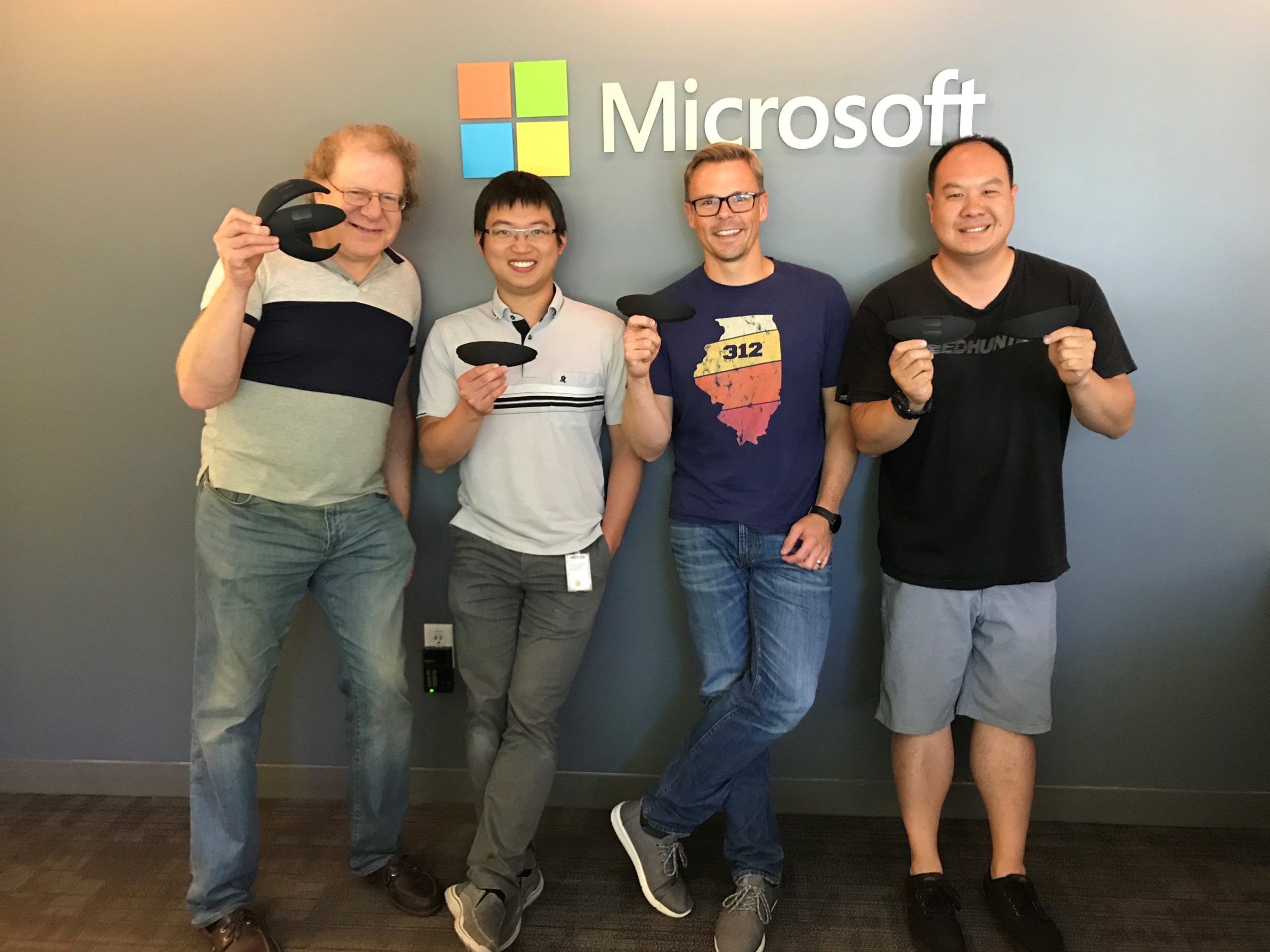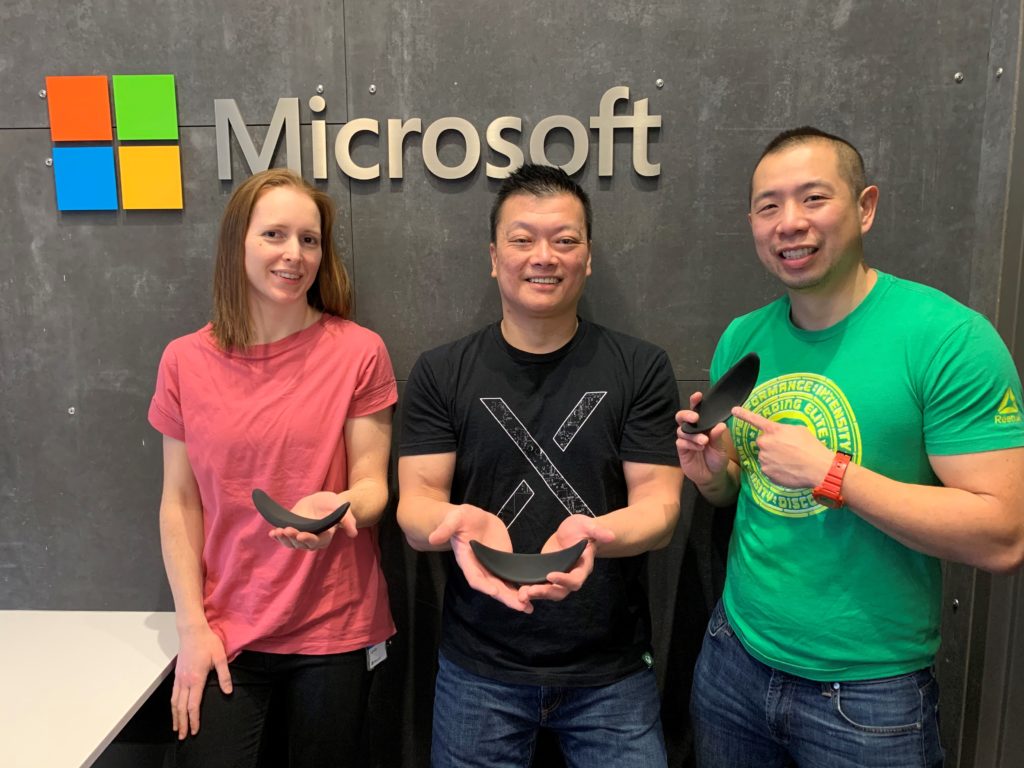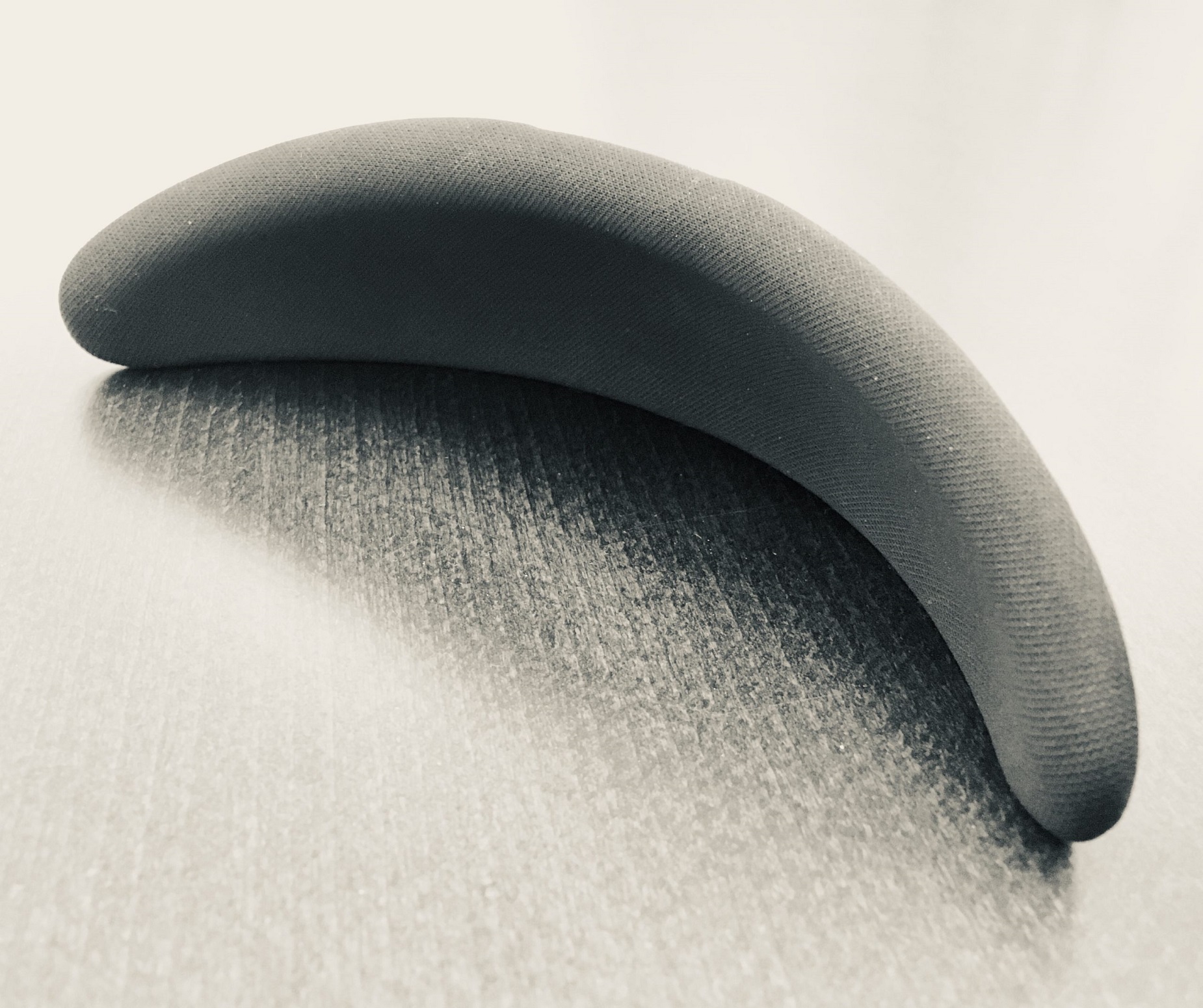 (Our local HoloLens team that partnered to help solve this brow-beating challenge, left to right: Shahar Ben-Menahem, Michael Lin, Jason Williams, Edwin Pham)
(Our local HoloLens team that partnered to help solve this brow-beating challenge, left to right: Shahar Ben-Menahem, Michael Lin, Jason Williams, Edwin Pham)
How do you make a fully operating, untethered mixed reality headset comfortable? That was the problem our own Jason Williams and Michael Lin, both engineers on our HoloLens hardware team here in the Bay Area, were asked to solve for the HoloLens 2 device.
The mission was to design a headset that fit better than the old one, could be worn longer, and was more comfortable. “It’s not like designing a phone,” says Williams. “We’re putting a device on your head, and we expect you to use it for the same amount of time you use your phone. But the phone is infinitely lighter—and you can switch between hands to hold it. The headset comfort problem is much more difficult.”
The original HoloLens was deliberately designed to put less weight on users’ noses. People tend to feel uncomfortable with heaviness there. However, it also means most of the weight of the device rests on your brow. As a result, the “brow-pad,” a pliable piece of material supported by a user’s forehead is one of the most important comfort factors.
Sizing one for all
Every person’s head shape is unique. There are small oval and big round heads. Heads with large and small foreheads with different slopes. Distinctive men and women sizes. People with lots of hair, curly or straight, and those with no hair at all.
“We knew the first devices grew uncomfortable to wear due to pressure hotspots on the head, but we didn’t know how to fix it for everyone,” says Lin. “We were using industry standards and coming up with new shapes for the brow-pad to solve for all the different sizes and key distinctive features of people’s heads. Each iteration was comfortable to some, but more uncomfortable for others.”
Comfort in the end is subjective and the HoloLens 2 needed to fit multiple right out of the box. Along with unique features, each person has her or his own tolerance and scale for discomfort. This makes the brow-pad a critical component to how long someone could use the device comfortably.
 (The team had to consider many different shape and size variations of foreheads, an example above of the variance between two users)
(The team had to consider many different shape and size variations of foreheads, an example above of the variance between two users)
Quantifying comfort
Lin, Williams, and Human Factors Engineering, a group of engineers dedicated to understanding the different senses of people for better product design, knew using general sizes and industry standards would not work. The HoloLens 2 needed to be designed to work for everyone.
It just so happened the Human Factors team was a year into a labor-intensive project to digitize and measure human body dimensions for wearable computing. The data for the forehead would prove invaluable to quantifying comfort and optimizing the shape of the brow-pad.
Data in hand, Lin and Williams then asked a small sample size of Microsoft employees to wear the device to determine how people liked to place it on their heads. Everyone wore it differently. They observed differences in how people put on the device and asked why they felt uncomfortable over time. These observations helped them identify three main categories for comfort:
- How well does the pad fit and distribute force across the user’s forehead shape?
- How much pressure is the user able to tolerate on their forehead?
- How does the shape of brow-pad affect the angle and distance between the user’s eyes and the display?
“Immediately we had three solid metrics,” says Lin. “By breaking it down into these categories, quantifying comfort became clear. By partnering with the Human Factors Engineering team we were able to get a far more accurate understanding of what would work for everyone from the study they were running.”
“Hair was a unique issue. There are so many products that change the amount of friction. Without friction between the hair and the device there is a slippage issue, so that was something we had to account for.” – Jason Williams, director of mechanical engineering for HoloLens
 (The Human Factors Engineering group’s research helped quantify comfort in an entirely new way, left to right: Lynda Horton-Jones, Y.K. Cheong, Ryan Chang)
(The Human Factors Engineering group’s research helped quantify comfort in an entirely new way, left to right: Lynda Horton-Jones, Y.K. Cheong, Ryan Chang)
Analyzing the data
Once data was collected, it was time to create an algorithm to put parameters around the new brow-pad design.
Lin went to the Core Technology team for help. They brought in Shahar Ben-Menahem, a HoloLens resident physicist to create a mathematical model for the information. “Shahar is actually an astrophysicist. He had to do most of the modeling for us since the problem with our device is so unique,” says Lin.
One interesting consideration that went into the effort was pressure. How much can each user tolerate? The reason we feel pain is because blood vessels are getting compressed. The brow-pad essentially presses down on the forehead for balance. Meaning that PSI (pounds per square inch) of pressure can become discomforting after a certain period.
“There is the added complication that if the foam doesn’t have the right stiffness and compression behavior. The pressure goes up in certain locations to form hot spots. It meant that people with protruding slopes received higher pressure,” says Lin. “This formula also helped us find the right material that has the ideal behavior in the appropriate range of compression.”
 (Mechanical CAD image of the HoloLens 2 brow-pad)
(Mechanical CAD image of the HoloLens 2 brow-pad)
Testing the prototypes
For months, the team tested the HoloLens 2 prototypes. They would measure “comfort scores” determined by ranking each of the three categories along with each test group’s subjective feedback.
“Users would come in and run through different activities, both physical and stationary,” says Williams. “We asked them, how does it feel to have this weight on your head?”
Lin and the Human Factors Engineering team would then take these scores and analyze them by asking “why” each time a sub-optimal result was given. The prototypes evolved to address core areas of concern. Lattice framework was tested for breathability. Shapes were considered for fit. Different materials were evaluated for pressure. And after all these were thoroughly tested, the brow-pad still had to be integrated into a device made up of many other parts.
The other components of the device dictated needs for the brow-pad. “We have to consider everyone from silicon design, to electrical engineering systems, mechanical design, and a bunch of other teams. We wanted a holistic design.” says Williams. The team had to account for the balance of the device, weight distribution, and all the other new technology within that would put pressure on the brow-pad.
 (The HoloLens 2 finished brow-pad)
(The HoloLens 2 finished brow-pad)
A true team effort
Everyone from mechanical engineers, physicists, industrial designers, materials and human factors engineers contributed to the design of the brow-pad. Bringing together team members across all areas of expertise is what makes designing new hardware at Microsoft exciting.
“We have people on our team that are experts in consumer electronics design. But what makes our day interesting is when you partner them with an aeronautical or space system engineer,” says Williams. “They approach the same problem from different perspectives, with different skills, and it gives our collective team a really unique culture.”
Microsoft is hoping HoloLens 2 will be used for everything from design, data analysis, medical imaging, standard computing, gaming, and more. If you are interested in joining our hardware teams locally, please visit us at: https://aka.ms/MicrosoftBayAreaCareers




